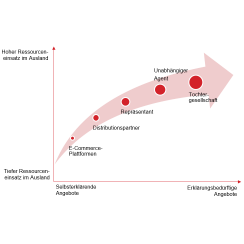There are a number of possibilities for sales. From a digital platform, to a distribution partner, to a subsidiary, there are many options for selling your goods and services.
- Should one choose a distribution and sales partner, who includes your offerings in a portfolio with many others?
-
Or is an independent agent better, who can spend more time on your products but may also need more marketing support from Switzerland?
- Should you consider founding your own subsidiary from the outset, via which you can control all activities yourself?
Indirect versus direct export – what needs to be considered?
When entering a new market, companies often opt for indirect export, i.e. cooperation with a local business partner (distribution model). This allows company entering the market for the first time to profit from existing customer reach, skills and networking of a sales partner in the target market and thus reach the market more quickly. On the other hand, the proximity to the end customer decreases, and the control over the activities for market cultivation lies with the partner, whose priorities are not always the same as those of your company.
In the case of direct exports, however, the exporter directly sells the goods to the target market. For products and solutions that require a lot of explanation and intensive customer care, it may also be advisable to appoint local specialists with technical and sales expertise as economically independent individuals for market development and customer care (agents or representatives on a commission basis). Since extensive knowledge of foreign markets and home market cultivation are necessary here, the overall capital requirement should not be underestimated.
Combined and self-directed market cultivation models
With growing experience, combined models can also be used to increase market penetration. To avoid unwanted competition, market activities must be closely compared with the partners involved and the sub-markets and customer segments must be clearly and logically defined.
Direct, self-directed market development via a sales team or a subsidiary is one form of internationalization with great economic potential that is particularly suitable for exporters with existing local market experience; it does, however, entail higher capital requirements and greater risks.
In practice: Biokema S.A., a pharmaceutical laboratory for veterinary medicine in Crissier, opted for indirect distribution in China. The market analysis showed that a local partner is required due to the market’s particularities. Florence Cousté-Bémer, responsible for Biokema's international business, says: “We could have joined an international laboratory to distribute our products, but even that would require a Chinese partner. This approach would have further reduced our margins.”
Biokema chose the company that showed the greatest willingness to cooperate and with whom the exchange was most active. The negotiations on the terms of the contract then began – an undertaking that proved difficult due to China's particularities. The company sought help in this regard, in this case from a Chinese lawyer who is very familiar with the legal and cultural differences between Switzerland and China. “The negotiations in the run up to contract signing were long and complicated,” Florence Cousté-Bémer concludes. But the effort was worth it, not only because of the country's great potential. “China is forcing us to do things differently, to improve in order to be more efficient and profitable. This is good preparation for tackling other emerging markets!”
Initial recommendations for action
- Compare multiple business models and identify factors that are critical fro the customer in the target market: Which activities can be centralized and which must be carried out from the market? Which services can be delegated to a partner, which services must your company provide itself?
The next step involves market mechanisms abroad and useful tips on becoming familiar with them. Learn more about it here!
Here you can download the complete guide to getting started exporting and benefit from an overview of all sales models with decision-relevant factors.Donwload the «Export compact» handbook now!







